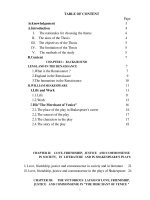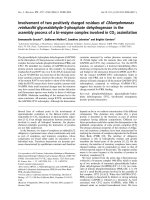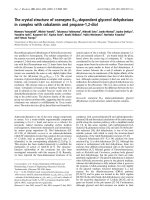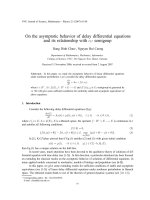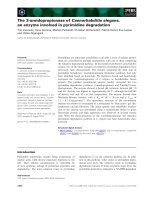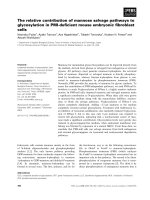The vocalization behavior of cat ba langur trachypithecus poliocephalus in cat ba national park
Bạn đang xem bản rút gọn của tài liệu. Xem và tải ngay bản đầy đủ của tài liệu tại đây (905.92 KB, 55 trang )
MINISTRY OF AGRICULTURE AND RURAL DEVELOPMENT
VIETNAM NATIONAL UNIVERSITY OF FORESTRY
STUDENT THESIS
Title
THE VOCALIZATION BEHAVIOR OF CAT BA LANGUR
(TRACHYPITHECUS POLIOCEPHALUS) IN CAT BA NATIONAL PARK
Major: Natural Resources Management
Faculty: Forest Resources and Environmental Management
Student: Do Bao Ngoc
Student ID: 1453091115
Class: K59A Natural Resources Management
Course: 2014 – 2018
Advanced Education Program
Developed in collaboration with Colorado State University, USA
Supervisor: Assoc. Prof. Vu Tien Thinh
Hanoi, September 2018
ACKNOWLEDGEMENT
First of all, I would like to sincerely thank you for my supervisor Assoc. Prof Vu
Tien Thinh and Mr. Tran Van Dung have supported me in my studies, guides science in the
research process, their patience, motivation, and extensive knowledge. Thanks for two
peoples who supported me during the research and writing of this thesis.
I sincerely thanks to Mr. Nguyen Huy Cam (the forest ranger), Mr. Mai Sy Luan
(CBLCP), Cat Ba Langur Conservation Project Organization, FFI Organization, Cat Ba
National Park. I extremely thankful and grateful to them for sharing the knowledge,
experience, and supported me about the boat and fuel for during this thesis.
Furthermore, I would like to thanks my family and my friends for supporting me in
my research. Without their support, I would not be able to complete the study.
During fieldwork due to time, the weather is not favorable, as well as access to the
relatively difficult area. Therefore, I will have the inevitable shortcoming in the research
process. I am looking forward to receiving the sympathy and comment from the teacher
and friends to complete the thesis is better.
Thank you!
Hanoi, September 2018
Do Bao Ngoc
CONTENT
ACKNOWLEDGEMENT ..................................................................................................... 2
PART I. INTRODUCTION ................................................................................................... 2
1.1 Species overview ......................................................................................................... 4
1.1.1 Taxonomy ............................................................................................................. 4
1.1.2 Distribution .......................................................................................................... 7
1.1.3 Morphological characteristics ............................................................................. 9
1.1.4 The vocalization of trachypithecus. ................................................................... 10
1.2 Conservation and threat of Cat Ba Langur........................................................... 11
1.2.1 Conservation ...................................................................................................... 11
1.2.2 Threat of Cat Ba Langur ................................................................................... 13
PART II. GOALS AND OBJECTIVE ................................................................................ 14
2.1 Goal: .......................................................................................................................... 14
2.2 Objective: .................................................................................................................. 14
2.3 Study area ................................................................................................................. 14
PART III. STUDY SITE ..................................................................................................... 16
3.1 Natural conditions.................................................................................................... 16
3.1.1 Geographic location ........................................................................................... 16
3.1.2 Climate and hydrology ....................................................................................... 16
3.1.3 Vegetation ........................................................................................................... 17
3.1.4 Fauna ................................................................................................................. 19
3.2 Economy - Society .................................................................................................... 20
3.2.1 Population and employ ...................................................................................... 20
3.2.2 Livelihood ........................................................................................................... 21
PART IV. METHODOLOGY ............................................................................................. 24
4.1 Field surveys method ............................................................................................... 24
4.1.1 Determine the age/sex structure of Cat Ba langur ........................................... 24
4.2 Data collection .......................................................................................................... 27
4.3 Semi - structure interviews survey ......................................................................... 29
4.4 Data analysis ............................................................................................................. 29
PART V. RESULTS AND DISCUSSION .......................................................................... 30
5.1 Result......................................................................................................................... 30
5.1.1 The status and structure of Cat Ba langur ....................................................... 30
5.1.2 Vocalization of Cat Ba langur.......................................................................... 31
5.1.3. Vocalization behavior of Cat Ba Langur. ........................................................ 35
5.2 Discussion: ................................................................................................................ 37
5.2.1 Give some solution to improve the conservation and development of Cat Ba
Langur. ........................................................................................................................ 38
PART VI, CONCLUSION AND RECOMMENDATIONS ............................................... 40
6.1 Conclusion: ............................................................................................................... 40
6.2 Recommendations:................................................................................................... 40
REFERENCES
APPENDIX
LIST OF FIGURES
Figure 1.1: Map showing the distribution of Cat Ba langur populations in Cua Dong
(southeast), the sanctuary (east), and Hang Cai (northwest) on Cat Ba Island, Vietnam.
Map, with permission, from Leonard (2014). ........................................................................ 9
Figure 1.2: Male Adult. Photo by Nguyen Huy Cam .......................................................... 10
Figure 1.3: Female Adult. Photo by Nguyen Huy Cam....................................................... 10
Figure 1.4: Infant. Photo by Nguyen Huy Cam ................................................................... 10
Figure 2.1: Cua Dong. Photo by Neahga Leonard ............................................................... 14
Figure 2.2: Hang Cai - Gia Luan Commune. Photo by Neahga Leonard ............................ 15
Figure 2.3: Sanctuary. Photo by Neahga Leonard ............................................................... 15
Figure 4.1: Juveniles. Photo by Nguyen Huy Cam
........................................................ 26
Figure 4.2 Subadults. Photo by Nguyen Huy Cam .............................................................. 26
Figure 4.3: Newborn. Photo by Nguyen Huy Cam.............................................................. 27
Figure 1.1: The sound spectrum of the Adult male ............................................................. 31
Figure 5.2: The sound spectrum of Juveniles ...................................................................... 32
Figure 5.3: The sound spectrum of Infants .......................................................................... 33
Figure 5.4: The behavior of Cat Ba langur .......................................................................... 35
Figure 5.5: The vocalization behavior of Cat Ba langur by time ........................................ 37
LIST OF TABLES
Table 3.1: The population situation of the commune, town in Cat Ba island ..................... 21
Table 4.1: The characteristic of Cat Ba Langur ................................................................... 25
Table 4.2: The behavior of Cat Ba langurs .......................................................................... 28
Table 4.3: Define the behavior of Cat Ba langurs ............................................................... 28
Table 5.1: Population size, age-sex classes for Cat Ba langurs as of July 2018.................. 30
Table 5.2: The vocal frequency of adult males (n=6) .......................................................... 31
Table 5.3: The vocal frequency of juveniles (n=3) .............................................................. 33
Table 5.4: The vocal frequency of Infants (n=4) ................................................................. 34
Table 5.5: The number of vocal by individual..................................................................... 36
ABBREVIATION
°C
degrees Celsius
CBLCP
Cat Ba Langur Conservation Project
CBNP
Cat Ba National Park
cm
centimeter
EPRC
Endangered Primate Rescue Center
FFI
Fauna and Flora International
Ha
Hectare
IUCN
International Union for Conservation of Nature
km
Kilometers
mm
millimeter
$
currency ($) for USA
Hz
Hertz
ABSTRACT
This study describes the vocalization behavior of Cat Ba Langur (Trachypithecus
poliocephalus) in Cat Ba Island, Hai Phong City, Vietnam. This research has never been
described before. The main objective is to describe and to identify the vocal of Cat Ba
Langur. Information derived from the recordings of the langur when I go to the field and
then I used the Raven Pro software for analyzing the data. For the result, I explored the
maximum and minimum of the highest spectrum and the lowest spectrum of three
individuals (Male adults, Juveniles and Infants), the time in the day them emitted the vocal
and structure of the herd. We detected 8 groups with 59 individuals in the field and give
some solution for conservation and development of Cat Ba Langur. In natural, the langur
always moving, so the operation of the voice recorder is not fixed and difficult for
collected data. Therefore, I should have a long time for study, need to collect data of Cat
Ba langur on EPRC in Cuc Phuong National Park to compare the differences between the
captive and the wildlife.
1
PART I. INTRODUCTION
Vietnam has a high diversity of primates; 25 species and subspecies of primates are
known to occur there (Fooden 1996; Roos et al. 2007; Van Ngoc Thinh et al. 2010).
However, a fast-developing economy combined with illegal wildlife trade, habitat
degradation, and hunting has led to population declines in all species (Lippold and Vu
Ngoc Thanh 1998). According to the result of the Asian Primate Assessment Conference in
Singapore (2015), Primate in Vietnam is in particularly serious condition. The number of
species classified as "Critically Endangered" increased from 7 species in 2008 to 11
species in 2015. One of these 11 species, arguably the most endangered in Vietnam is the
Cat Ba langur (Trachypithecus poliocephalus), which occurs only on Cat Ba Island in
Northern Vietnam.
Cat Ba langur (Trachypithecus poliocephalus) is a critically endangered langur.
Two subspecies are recognized: T. p. poliocephalus in Cat Ba Island, Vietnam, and T. p.
leucocephalus in Guangxi, China. The former (the nominate subspecies), often known as
the golden-headed or Cat Ba langur, is among the rarest primates in the world, and
possibly the rarest primate in Asia, with a population size estimated at less than 60
individuals. Both subspecies are overall blackish, but the crown, cheeks, and neck are
yellowish in T. p. poliocephalus, while they are white in T. p. leucocephalus, as suggested
by its scientific name (ARKive. Accessed, 2008). According to the Cat Ba Langur
Conservation Project, the Cat Ba langur's skin is black and the pelage color is dark brown;
head and shoulder are bright golden to yellowish-white. The tail is very long (ca. 85 cm)
compared with the body size (ca. 50 cm). Babies are colored golden-orange; the pelage
starts to change its color from about the fourth month on. Males and females look alike.
The Cat Ba Langur, which lives on Cat Ba Island in Vietnam, is one of the 25 most
endangered primates. Conservation efforts are helping to prevent this, however, and have
2
greatly increased their population since 2003, when there were only 40. Until recently, the
Cat Ba Langur was not considered a species but rather a subspecies of other Langurs that
live in the Vietnam jungles (Mongabay Environmental News). Cat Ba Langurs are diurnal
creatures and travel in groups of about four to eighteen animals. They prefer the steep
limestone cliffs that make up most of Cat Ba Island. Most of the places that they are found
are not accessible to humans by foot. Cat Ba Langurs spend around 66% of their time
resting and the rest moving, foraging, and socializing, with the distribution changing
between summer and winter (Schneider et al, 2010). They eat less and rest more in the
winter and the opposite in the summer.
The World Conservation Union (IUCN) lists the Cat Ba langur as one of the most
critically endangered primate species in the world due to its small population size and
restricted range. Only about 60 langurs currently survive in the wild. The Endangered
Primate Rescue Centre at Cuc Phuong National Park is the only facility housing captive
Cat Ba langurs (Cat Ba Conservation Project, 2006). In the past, poaching constituted the
primary threat to langur survival and resulted in a population decline from an estimated
2,500-2,800 individuals in the 1960s, to a mere 53 individuals by 2000. As a result of this
steep decline in numbers, the remaining langur population is now highly fragmented and
low reproductive output threatens their future survival. The population of the Cat Ba langur
is scattered around the island in several isolated sub-populations. Some of these include
all-female groups with no access to males and are therefore non-reproducing social units.
Langurs were mainly poached for the preparation of traditional medicine, referred to as
“monkey balm”, and only rarely for use as food, as their meat has a very unpleasant smell.
(Cat Ba Langur Conservation Project, 2004).
In the world, there are many types of research about vocalization of Primate.
Example: "Calling patterns of Western purple-faced langurs (Mammalia: Primates:
3
Cercopithecidea: Trachypithecus vetulus nestor) in a degraded human landscape in Sri
Lanka" (C. Eschmann et al, 2008), Concordance between vocal and genetic diversity in
crested gibbons (Van Ngoc Thinh et al, 2011), Vocal Diversity and Taxonomy of Nomascus
in Central Vietnam and Southern Laos (Julia Ruppell, 2007). In Vietnam, we have a draft
of "Vocalization of red- and grey-shanked douc langurs (Pygathrix nemaeus and P.
cinerea) (Isidoro et al, 2013). However, we do not have any research to determine the
vocalization of Cat Ba Langur. We have research for "Behavioral Observations and Notes
on the Vertical Ranging Pattern of the Critically Endangered Cat Ba Langur
(Trachypithecus poliocephalus poliocephalus) in Vietnam" by Isabell Schneider et al,
2010. In additions, the study about Cat Ba langur is still limited, the effect of climate
change can be declining the habitat of this species. In another hand, the knowledge about
the ecological characteristics of this species is low, it also causes obstacles to the
management and conservation. Therefore, in order to provide ecological information of
Cat Ba langurs to contribute to the conservation of rare endemic rare species in Vietnam, I
conducted the following research: "The vocalization behavior of Cat Ba Langur
(Trachypithecus poliocephalus)". The results collected from this research will add new
scientific information to primate species in Vietnam and provide an important scientific
basis for policymakers to propose solutions to preserve this endemic species.
1.1 Species overview
1.1.1 Taxonomy
Cat Ba langurs, also known as golden-headed langurs or „Cang den dau
trang‟/„vooc Cat Ba‟ in Vietnamese (Nisbett and Ciochon 1993; Nguyen Cam pers. comm.
2014) are a Critically Endangered (Bleisch et al. 2008a) leaf-eating monkey within the
family Cercopithecidae and subfamily Colobinae of Old-World monkeys, endemic to a
small Vietnamese island – Cat Ba Island.
4
1.1.1.1 Colobines
Early colobines moved into arboreal and folivorous niches by the late Pliocene
(Jablonski 2002). They then divided into two tribes: the African (Colobini; which includes
the genera Procolobus, Piliocolobus, and Colobus), and the Asian [Presbytini; which
includes the odd-nosed group (Nasalis, Rhinopithecus, Simias, and Pygathrix), and the
langur, or leaf, monkeys (Trachypithecus, Presbytis, and Semnopithecus)] (Groves 2001)
somewhere around 10.9-15.39 million years ago (Delson 1994; Sterner et al. 2006; Meyer
et al. 2011; Roos et al. 2011). The original Asian group then again split around 6.9 million
years ago into the odd-nosed and leaf-eating groups (Sterner et al. 2006). The Asian group
has retained the primitive features in their molars, premolars, jaw bone, feet bones, and
thumb, which were more derived in the African group (Strasser and Delson 1987; Groves
1989).
1.1.1.2 Asian Colobines
Debate continues as to the relatedness of the Asian colobines (Karanth 2010),
particularly between Rhinopithecus, Pygathrix, and Trachypithecus (Oates et al. 1994;
Wang et al. 1997), although each genus has been shown to be monophyletic (Sterner et al.
2006). There is confusion as to whether or not Presbytis is sister taxon to Trachypithecus
and Semnopithecus, or if Semnopithecus is sister to the other two, and where these
divisions stand in relation to the odd-nosed group of Asian colobines (Strasser and Delson
1987; Groves 1989; Pan and Groves 2004; Sterner et al. 2006; Kirkpatrick 2007; Osterholz
et al. 2008; Ting et al. 2008; Meyer et al. 2011; Perelman et al. 2011; Roos et al. 2011).
The questionable relatedness among the langurs is a complex issue, possibly due to past
hybridization between them (Osterholz et al. 2008; Roos et al. 2011) or morphological
convergence (Perelman et al. 2011). Their perceived relatedness, therefore, depends on
5
what is being tested (e.g. morphology, nuclear vs. mitochondrial DNA), although this does
not change the true nature of their evolution and phylogeny.
1.1.1.3 Trachypithecus
While the genus Trachypithecus used to be said to include five species-groups, T.
obscurus, T. cristatus, T. Francois, T. pileatus, and T. vetulus (Groves 2001; Roos 2003),
the last two have been found to be genetically closer to the Semnopithecus (T. pileatus is
the result of hybridization with Semnopithecus in the past and retains the Trachypithecus
genus name, whereas T. vetulus should always have been considered part of
Semnopithecus: Zhang and Ryder 1998; Roos 2003). As a result, Trachypithecus now
includes only three species-groups (T. obscurus, T. cristatus, and T. francoisi groups)
(Harding 2010) that separated 3.17 ± 0.31 million years ago (Roos et al. 2008). The
number of species within the genus as a whole is questionable, ranging from 17-20 species
(Harding 2010). This study follows the most updated taxonomic list for Asian species in
recognizing 20 Trachypithecus species (Roos et al. 2014). The francoisi species-group of
limestone langurs include Delacours, Laotian, Hatinh, Indochinese black, Franỗois, Cat
Ba, and white-headed langurs (Groves 2007). All of these animals live on limestone karst
mountains (Groves 2007), resulting in similar ecological, locomotor, and nutritional
challenges.
The francoisi species-group can be further divided into the northern
(Franỗois, Cat Ba, and white-headed langurs) and the southern (Delacour’s, Laotian,
Hatinh, and Indochinese black langurs) groups (Roos 2003; Roos et al. 2007), whose
ranges are divided by the Red River (Groves 2007).
1.1.1.4 Trachypithecus poliocephalus
According to the Cat Ba Langur Conservation Project, The Cat Ba langur's skin is
black and the pelage color is dark brown; head and shoulder are bright golden to
yellowish-white. The tail is very long (ca. 85 cm) compared with the body size (ca. 50 cm).
6
Babies are colored golden-orange; the pelage starts to change its color from about the
fourth month on. Males and females look alike. The Cat Ba langurs live in groups, usually
one male with several females and their offspring. They are diurnal animals, adapted to
living in limestone habitat. Each group has its own territory, defended by the adult male
who also initiates the location of the group. The females usually give birth to a single baby
every 2–3 years, which becomes mature at 4–6 years old. Langurs have an average life
expectancy of 25 years. Food mainly consists of leaves, but also fresh shoots, flowers,
bark, and some fruits
1.1.2 Distribution
Vietnam has the richest diversity of primate taxa in Southeast Asia (Nadler 2010).
Within the country‟s borders, there are two species of Lorisidae (both genus Nycticebus),
18 species of Cercopithecidae (five Macaca, eight Trachypithecus, three Pygathrix, and
one Rhinopithecus), and six Hylobatidae (Nomascus) (Roos et al. 2014). The majority of
these species are on the IUCN Red List and classified from Vulnerable to Critically
Endangered (Nadler 2010). Two or three of these primate species (Cat Ba and Delacour’s
langurs and possibly gray-shanked doucs, Pygathrix cinerea) are strictly endemic to
Vietnam (Roos et al. 2014) while one other is near endemic (Cao-Vit gibbon, Nomascus
nasutus) or may now be endemic due to local extirpations elsewhere (Tonkin snub-nosed
langur, Rhinopithecus avunculus) (B Rawson pers. comm. 2015). However, political
borders have little to do with where nonhuman primates' range.
If we look at a
biogeographically relevant area (east of the Mekong River), over half of the primates are
endemic (Groves 2007).
1.1.2.1 Trachypithecus
Trachypithecus occur across a large range both geologically and ecologically.
They survive in moist and wet lowland forests, dry deciduous forests, mangrove swamps
7
along the coast, and broad-leaved forests in the mountains (Oates et al. 1994).
Trachypithecus are sympatric with Presbytis on the Malaysian and Indonesian islands, with
Nasalis on Borneo, and with Pygathrix in Indochina (Oates et al. 1994). The eight
Trachypithecus species within Vietnam include the gray, margarita (Trachypithecus
margarita), Indochinese lutung (Trachypithecus germaini), Franỗois, Cat Ba, Hatinh,
Delacour’s, and Indochinese black langurs (Groves 2007; Nadler 2010; Roos et al. 2014).
The latter five are limestone langurs.
Limestone langurs live on limestone karst
mountains around northern Vietnam, central and northern Laos, and southern China
(Groves 2007). Franỗois langurs exist in the largest and farthest north area of all the
limestone langurs, living in southwest China and northern Vietnam (Bleisch et al. 2008c;
Roos et al. 2014). White-headed langurs have a much smaller distribution than, and are
parapatric with Franỗois langurs; they live in Guangxi Province, China (Li et al. 2003).
Delacour‟s langurs are in northcentral Vietnam (Roos et al. 2014). Laotian langurs are
found in central Laos, just north of Hatinh langurs where these latter extend across the
border (Roos et al. 2014). Hatinh langurs are the southernmost limestone langur, occurring
in northcentral Vietnam and east-central Laos (Roos et al. 2014). Indochinese black
langurs are in east-central Laos and central Vietnam (Roos et al. 2014).
1.1.2.2 Trachypithecus poliocephalus
The Cat Ba langur is limited to Cat Ba Island, northeastern Vietnam. There is no
evidence these langurs ever occurred on the mainland, as no suitable limestone habitat is
nearby (Nadler et al. 2003). It is suggested that they originally colonized the limestone
range when sea levels were lower. Those ranges eventually became islands, cut off from
one another (Nadler et al. 2003; Mark 2009).
Cat Ba island (20°42‟-20°55‟N;
106°54‟107°10‟E) is the largest of hundreds of islands in the Cat Ba archipelago. As of
2006, roughly half of the 140km2 island is devoted to the CBNP (Sterling et al. 2006;
8
Schrudde et al. 2010), a subset of which is part of a sanctuary (a strictly protected zone
within the CBNP created for langur protection).
Figure 2.1: Map showing the distribution of Cat Ba langur populations in Cua Dong (southeast),
the sanctuary (east), and Hang Cai (northwest) on Cat Ba Island, Vietnam. Map, with permission,
from Leonard (2014).
1.1.3 Morphological characteristics
In Cat Ba langurs, adult pelage is dark brown/black, with the exception of the
bright golden-brown to yellowish-white on their head to shoulders. The back hair appears
brown at the roots, and is blacker towards the tips (Brandon-Jones 1995); the hairs are
approximately 10-12cm long (Trouessart 1911). There is a V-shaped „frosted‟ gray band
that goes from the thighs to above the root of the tail on the monkey‟s back; the roots are
the same color as the body while the terminal 5mm are bright silver-gray (Nadler and Ha
Thang Long 2000; Figure 1.2). Langurs have little sexual dichromatism with the exception
of females having a pubic patch of pale hairs and irregular skin coloration on their inner
9
thighs (BrandonJones 1995; Nadler and Ha Thang Long 2000; Figure 1.3). Infants are born
bright orange with no crest, and then start to change color as they age (Figure 1.4)
Figure 1.2: Male Adult. Photo by Nguyen Huy Cam
Figure 1.3: Female Adult. Photo by Nguyen Huy Cam
Figure 1.4: Infant. Photo by Nguyen Huy Cam
1.1.4 The vocalization of trachypithecus.
There have been some numbers of research on vocalization of trachypithecus since
early such as:
"Calling patterns of Western purple-faced langurs (Mammalia: Primates:
Cercopithecidea: Trachypithecus vetulus nestor) in a degraded human landscape in Sri
Lanka" (C. Eschmann et al, 2008). The author was a useful non-invasive method for
determining population densities and the taxonomic relationships of rare or cryptic animal
species. The result of the research was showing the impact of deforestation may be the
main cause of different calling patterns and this species had the calling patterns differed
10
from the other subspecies, suggesting that they may be used to distinguish subspecies and
their boundaries
The research of B.M. Md-Zain et al, 2011 about "The activity patterns of a group of
Cantor's Dusky Leaf Monkeys (Trachypithecus obscurus halonifer)". The author wants to
describe the activity budget of a group of Cantor's dusky leaf monkeys (Trachypithecus
obscurus) in Penang Botanical Garden, Malaysia. The result of the research described the
behavioral of species and the habitat, canopy used of this species. The result also shows the
percentage of vocalization behavior in the day of this species.
Primate fauna and ecology of Hatinh langur (Trachypithecus francoisi hatinhensis)
in Phong Nha – Ke Bang Nature Reserve, Quang Binh Province (Nguyen Manh Ha, 1999).
The author observed the behavior of the individual when it emitting the sound of the male
adult repeating " Huyt...Huỵt" repeat 2 to 3 times when the herd moving to another place
for a nap and come back to the cave. When the male adult determines the danger on the
herd, it will vocal "Huỵt...Huỵt" for the herd know and silence. However, do not have
complete data and possible.
But the Cat Ba langur (Trachypithecus poliocephalus) don't have the research on
the vocalization behavior of species. So, this thesis is the first time we have research on the
Cat Ba langur (Trachypithecus poliocephalus).
1.2 Conservation and threat of Cat Ba Langur
1.2.1 Conservation
With just 53 Cat Ba langurs in the wild and two in captivity at the Endangered
Primate Rescue Centre of Cuc Phuong National Park, the Cat Ba Langur Conservation
Project was started in 2000 by Műnster Zoo and the Zoological Society for the
Conservation of Species and Populations (ZGAP). Given the cause of the langur‟s decline,
11
the main aim of the project was to halt poaching, with the additional intention of promoting
conservation awareness amongst the inhabitants of Cat Ba Island. The project has been
extremely successful in dramatically reducing deaths as a result of poaching, bringing the
number from 30 deaths in the eight months prior to its start, to three deaths in the first four
years of the project. In this time nine langurs were born and have survived. The langurs are
closely monitored and protection measures are in place, particularly in the newly created
langur sanctuary within the National Park. This highly protected area is home to 20
individuals from a large, reproducing group, which are protected by a rotation of 20
rangers – an incredible ratio of one ranger to one langur. The sanctuary is visibly marked
around its circumference and is inaccessible to tourists. The Cat Ba Langur Conservation
Project has constructed two new ranger stations, provided boats to ease patrols and has
even seen the voluntary relocation of several local, floating households to support the
rangers (Cat Ba Conservation Project). The Cat Ba langur also has the support of Flora and
Fauna International‟s Flagship Species Fund (Mittermeier et al, 2005) and the Cat Hai
District Women‟s Union, who implemented a project entitled „Contributing to Biodiversity
Conservation in Cat Ba National Park through Community Activity‟ (Birdlife Indochina Cat Ba National Park, 2006).
Following the finding of a decline in the white-headed black langur in China,
efforts were made to conserve this subspecies. With funding from the Asian Development
Bank, a survey in January 2003 showed evidence of some recovery in the Fusui
populations (Mittermeier et al, 2005), and numbers in Chongzuo have seen a rise from less
than 100 to more than 200 individuals since Professor Pan Wenshi of Peking University
began a research program in 1996 that concentrated on the subspecies (Mittermeier et al,
2005). Tourism has become central to the economy of both Vietnam and China, and now
must be controlled to prevent the disturbance of recovering habitats and species in the
12
Conservation International‟s Indo-Burmese Biodiversity Hotspot (Birdlife Indochina - Cat
Ba National Park, 2006)
1.2.2 Threat of Cat Ba Langur
Hunting of the Cat Ba langur used to be common. The primary reason for hunting
was to supply the traditional medicine industry. Cat Ba langurs were used to make a
"monkey balm" believed to help with erectile dysfunction and other health issues. Since
the langurs are so few, hunting takes two to four weeks. A hunter can earn up to $50 from
a single langur, which is a lot when the average annual per capita income is less than $350
(Ben, 2003) Since it is so hard to find the langurs, the poachers do not go out with the
intent on capturing one, but often capture them by chance when hunting other animals in
the area. Between 1970 and 1986, an estimated 500 to 800 langurs were killed (Quan
Nguyen, 2010).
The hunters of the langurs have been known to attack people who get in their way.
As part of a conservation effort, "bodyguards" for the langurs have been put into place.
These guards are unarmed, and on several occasions have been severely hurt by the
hunters. Teeth have been knocked out and several have been stabbed. Because of the fear
of being attacked, the guards do not want to do their job anymore (Ben, 2003).
Cat Ba Island is in the process of creating a booming tourist industry. They are in
the process of building luxury hotels around the island, with one hotel being 17 stories tall
(Ben, 2003). To accommodate all the new tourists, the town of Cat Ba is building a new
road that will connect the town to a small village on the northern edge of the island where a
ferry will be to take tourists to another popular destination: Ha Long Bay. The road runs
just along a border of the park which may attract more hunters to the area (Ben, 2003).
13
PART II. GOALS AND OBJECTIVE
2.1 Goal:
To providing data on the characteristics and vocalization behavior of Cat Ba langur
(Trachypithecus poliocephalus) for the conservation of this rare species in Vietnam.
2.2 Objective:
- Describing the vocal repertoire of Cat Ba Langur.
- Identifying the calling pattern of Cat Ba Langur.
- Give solutions to improve the conservation of Cat Ba Langur.
2.3 Study area
- This research focus on 3 locations in Cat Ba Island: Cua Dong, Gia Luan Communes and
Sanctuary (a strictly protected zone within the CBNP created for langur protection).
Figure 2.1: Cua Dong. Photo by Neahga Leonard
14
Figure 2.2: Hang Cai - Gia Luan Commune. Photo by Neahga Leonard
Figure 2.3: Sanctuary. Photo by Neahga Leonard
15
PART III. STUDY SITE
3.1 Natural conditions
3.1.1 Geographic location
The distance from Cat Ba Island to Hai Phong is 45 kilometers to the East, 24
kilometers to the South of Ha Long City and Hanoi city about 150 km the Southeast. To
the North it borders Ha Long Bay, Quang Ninh Province; the West it borders Cat Hai
Island, Cat Hai district, Hai Phong city; the East and South are the East Sea.
Cat Ba island coordinates: 20°42' - 20°54' North latitude; 106°52' - 107°07' East
longitude.
Cat Ba National Park coordinates: 20°44'50'' - 20°55'29'' North latitude: 106°54'20''
- 107°10'05'' East longitude.
3.1.2 Climate and hydrology
Cat Ba island has an area of approximately 300 square kilometers.
Located in the tropical monsoon area affected by the oceans, the average indicator
about temperature, humidity, rainfall is equivalent to the surrounding area. But the region
has winter little colder and summer less hot than inland. However, due to differences in
topography and, the influence of the sea, special is influenced by factors such as altitude
direction of the mountain, forest vegetation that climate regimes also differ between
regions in the area.
Specifically:
Precipitation: Average annual precipitation is 1,700 - 1,800 mm/year, seasonal
fluctuations. The rainy season begins from May to October, but focusing mainly in July
16
and August. Precipitation during this season accounts for nearly 80 - 90% f the total annual
rainfall.
Temperature: the annual average temperature is 23.6 °C. The month with the
highest temperature is in July, average temperature from 28 - 29°C, the highest is 32°C,
and the lowest temperature of the month was January, the temperature average from 1617°C, the lowest of 10°C, maybe even down only 5°C. The hot season begins from May
and lasts until October, cold season from November to April the following year.
Humidity: Average air humidity is 85% of the year, the lowest in January was
73% the highest was 91% in April. Annual water evaporation approximately 700mm, in
the dry months often occur drought water shortage
Windstorm: In the region, there is 2 type of winds East-Northeast winds in the dry
season and East-Southeast winds in the rainy season. Also, storm usually occurs from June
to October; average 2.5 hurricanes per year. Often accompanied by heavy rainstorms cause
flooding, seriously affected the levee system, the aquaculture region.
Tidal oscillations: 3.3 - 3.9 m;
Salinity of sea: from 0.930% (rainy season) to 3.111% (dry season);
Hydrological characteristics: Cat Ba is an archipelago of limestone, almost all
river systems on the island is undeveloped. The temporary flow of appearing only in the
rain and stopped immediately after rain. In the rainy season, the water stagnant in some
small area, infiltration leaks in the cave. Although it's very little, then this is the water
sources necessary for animals and plants on the island.
3.1.3 Vegetation
Flora resources on Cat Ba Island abundant with statistics of 620 species belonging
to 438 genera and 123 families. The typical family: Myrtaceae, Moraceae, Rubiaceae,
Lauraceae, Asteraceae.
17
Dividing flora on Cat Ba Island, we have:
Medium and large wood trees: 68 species;
Small wood trees: 135 species;
Dust trees: 136 species;
Herbs: 174 species;
Vines trees: 87 species.
Composition plant in Cat Ba not really abundant, but still much value crops
economically and science as Fagraea fragrans, Chukrasia velutina, Aglaia spectabilis,
Podocarpus fleuyi. The most typical of the type of vegetation in Cat Ba island is the type of
evergreen rain moist forest on limestone, and mangroves forest vegetation type coastal,
estuaries. Additionally, in areas still appear some specific forest types and rare, it is kind of
submerged vegetation in high mountains.
In addition to the forest vegetation, agriculture vegetation type also plays a key role
in the region. This vegetation including plantation forests, perennials, agricultural crops,
fruits, aquaculture, and residential areas.
Due to many external factors such as terrain conditions, geology, climate,
hydrology... in the region have formed a closed forest of evergreen broadleaf tropical rain
on the island. In the past few decades, the forest has covered most of the land area of the
island. Currently, the natural forests have been impacted, making profound changes in
structure and forest canopy. However, the forest of Cat Ba is still regarded as a unique
forest on limestone of the East coast of North Vietnam.
18
